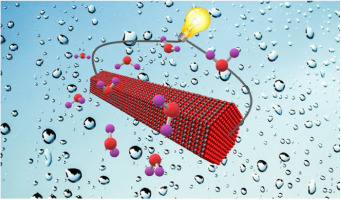在氧化锌(ZnO)纳米线(NWs)的制造和操作中,湿度效应是不可避免的。本文基于原子尺度模拟对ZnO纳米线在潮湿条件下的压电势特性进行了压缩研究。通过分子动力学模拟,我们发现在潮湿条件下,水在ZnO NWs表面的混合分子和解离混合吸附。分子水和解离水的吸收都在结构上重建了ZnO净水的表面原子,从而改变了它们的表面性能,最终使ZnO净水在潮湿条件下的材料性能与真空条件下的对应物显着不同。将获得的材料特性应用于ZnO NWs的压电势的数值和解析计算,我们发现湿度效应引起的压电势显着降低。与先前实验中观察到的结果相似,发现随着湿度水平的增加,压电势的降低变得更加明显,因为在此过程中,更多的ZnO NWs表面原子将被分子或离解的水吸附。此外,我们的密度泛函理论计算结果表明,湿度效应还可以通过向下移动ZnO NW的导带边缘来影响其半导体性能。然而,发现由湿度效应引起的半导体性质的变化对ZnO NW的压电势具有微不足道的影响。随着湿度水平的增加,压电势的降低变得更加显着,因为在此过程中,更多的ZnO NWs表面原子将被分子或离解的水吸收。此外,我们的密度泛函理论计算结果表明,湿度效应还可以通过向下移动ZnO NW的导带边缘来影响其半导体性能。然而,发现由湿度效应引起的半导体性质的变化对ZnO NW的压电势具有微不足道的影响。随着湿度水平的增加,压电势的降低变得更加显着,因为在此过程中,更多的ZnO NWs表面原子将被分子或离解的水吸收。此外,我们的密度泛函理论计算结果表明,湿度效应还可以通过向下移动ZnO NW的导带边缘来影响其半导体性能。然而,发现由湿度效应引起的半导体性质的变化对ZnO NW的压电势具有微不足道的影响。我们的密度泛函理论计算表明,湿度效应还可以通过向下移动它们的导带边缘来影响ZnO NW的半导体性能。然而,发现由湿度效应引起的半导体性质的变化对ZnO NW的压电势具有微不足道的影响。我们的密度泛函理论计算表明,湿度效应还可以通过向下移动它们的导带边缘来影响ZnO NW的半导体性能。然而,发现由湿度效应引起的半导体性质的变化对ZnO NW的压电势具有微不足道的影响。
 "点击查看英文标题和摘要"
"点击查看英文标题和摘要"
Humidity-dependent piezopotential properties of zinc oxide nanowires: Insights from atomic-scale modelling
The humidity effect is inevitable in the fabrication and operation of zinc oxide (ZnO) nanowires (NWs). In this paper, the piezopotential properties of ZnO NWs under the humidity condition are compressively investigated based on atomic-scale simulations. Through molecular dynamics simulations, we find a mixed molecular and dissociative adsorption of water on the surface of ZnO NWs under the humidity condition. Absorptions of molecular and dissociative water both structurally reconstruct the surface atoms of ZnO NWs and thus modify their surface properties, which finally make the material properties of ZnO NWs under the humidity condition significantly different from those of their counterparts under the vacuum condition. Applying the obtained material properties to the numerical and analytical calculations of the piezopotential of ZnO NWs, we find a significant reduction in the piezopotential induced by the humidity effect. Similar to the results observed in the previous experiments, the reduction in the piezopotential is found to become more significant as the humidity level increases, since in this process more surface atoms of ZnO NWs will be adsorbed by molecular or dissociated water. Moreover, our density functional theory calculations indicate that the humidity effect can also influence the semiconducting properties of ZnO NWs by downward shifting their conduction band edges. However, the change in semiconducting properties induced by the humidity effect is found to have trivial effect on the piezopotential of ZnO NWs.



































 京公网安备 11010802027423号
京公网安备 11010802027423号